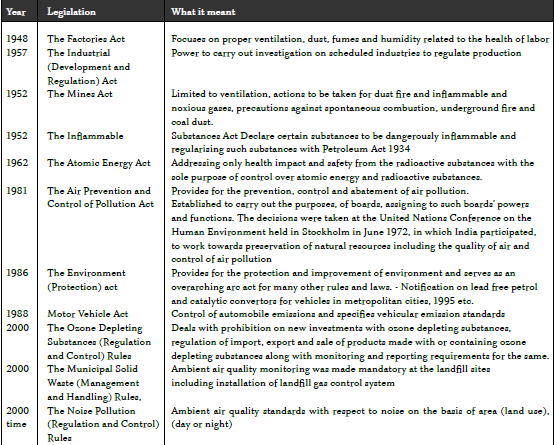
Air pollution in cities can be attributed to multiple sources and varies with location and developmental activities. In India, cities are growing at a rapid pace. Rising energy needs, growing number of vehicles, rampant construction and industrial activity is leading to increased air pollution. In addition, unsustainable consumption of resources and inappropriate waste disposal adds to emissions
Addressing air pollution is complex and requires strong legislative control. India’s air pollution legislation has a long history. In addition, legislative controls have also been driven by landmark judicial interventions. This article is a brief review of India’s air pollution policy in the context of history, present scenario and challenges of enforcement mechanisms.
Government Initiatives for Advancing Clean Air
While the history of air pollution policy dates back to pre -independence era, the first mention of environmental protection being in Kautilya’s Arthshastra, pre- independence acts like The Oriental Gas Company Act, 1857, Indian Penal Code, 1860, Indian Explosive Act, 1884, The Bengal Smoke Nuisance Act, 1905, were some legislative control measures that were directed to improve the environment with the objective of keeping the air clean. The Factories Act, 1948 was the first act of independent India that indirectly focused on air pollution. Following this, there were several acts like the Industrial (development and regulation) Act, the Mines Act, the Inflammable Substances Act, and so on that indirectly focused on reducing emissions. The Air Act of 1981 was the first act that focused directly on reducing air pollution followed by more sector specific legislations like the motor vehicles act and the municipal solidwaste acts.
Sector and Region -Specific Legislation
In addition to the above regulations, there have been sector specific legislations that have been introduced in areas like climate regulation, vehicular emissions control and others, with special focus on the Delhi National Capital Region (NCR) region. Under the Air (Prevention and Control of Pollution) Act 1986, the Central Pollution Control Board (CPCB) of India, directed forty-two measures to mitigate air pollution in major cities, including Delhi and NCR, through the implementation of an air action plan. In 1998, the Ministry of Environment, Forest and Climate Change, established the Environmental Pollution (Prevention and Control) Authority (EPCA) for the NCR of Delhi. The EPCA was given the authority to control and address environmental pollution. A landmark legislation was based on one such recommendation of EPCA when the Supreme Court, in July 1998, directed that all public transport vehicles comprising taxis, three wheelers, and buses in Delhi to run only on Compressed Natural Gas (CNG) after April 2001. To keep vehicular pollution levels in check, the government introduced the Bharat Stage Emission Standards (BSES). Through the BSES emission standards, Government of India regulates the output of air pollutants from internal combustion engines and spark-ignition engines. The standards which are based on European regulations were first introduced in 2000. Stringent norms have been rolled out progressively since then.
In 2015, the Ministry of Environment Forest and Climate Change, Government of India (MoEFCC, GoI) submitted its Intended Nationally Determined Contributions (INDCs) on climate change with the objectives of a cleaner and climate friendly economic development, reduction in emissions, promotion of non-fossil fuel based energy resources, development of additional carbon sink of 2.5 to 3 billion tons of CO2 equivalent through additional forest and tree cover by 2030, among others.
The Construction and Demolition Waste Management Rules (C&D Rules) were published in 2016, to tackle the issues of pollution and
waste management. In 2018, a Dust Mitigation notification making mandatory dust mitigation measures in infrastructure projects and demolition activities in the country was published. The National Green Tribunal (NGT) in 2019, directed state pollution control boards to install air quality monitoring stations and to report to the CPCB on the installation of the stations by
April 1, 2020. One of the significant aspects of air pollution legislation in India has been the judicial responses for environmental issues as Public Interest Litigations (PIL). Many key judgements have been provided to drive enforcement; a major one being the Taj Trapezium Case, Agra where the writ petition was filed by
MC Mehta regarding pollution caused to the Taj Mahal in Agra. Other issues where the judiciary has driven action include reducing vehicular emissions in Delhi and removal of hazardous industries from Chembur, to name a few.
History of Air Pollution Legislation in India

National Clean Air Action Programme
On the January 10, 2019, MoEFCC launched a five-year National Clean Air Action Programme (NCAP) to tackle the problem of air pollution. The overall objective of the NCAP is to take comprehensive mitigation actions to prevent, control and abate air pollution while supporting the national air quality monitoring programme, strengthening awareness and building capacity.
NCAP has identified 122 non-attainment cities that do not meet the annual average ambient air quality standards for PM 10. These cities have been identified based on ambient air quality data obtained (2011-2015) under National Air Quality Monitoring Programme (NAMP). The NCAP has set a tentative national level target of 20-30 per cent reduction of PM (PM2.5 and PM10) concentrations by 2024 using 2017 as the base year.
NCAP’s approach includes collaborative, multi-scale and cross-sectoral coordination between the relevant central ministries, state governments and local bodies. This includes coordination with existing policies and programmes, such as the National Action Plan on Climate Change (NAPCC) and the Climate Smart Cities Assessment Framework.
Making Legislation Effective
India, a vast country with an emerging economy, faces major challenges in its growing population and widespread poverty. The enormous challenges in meeting commitments associated with poverty reduction and eradication of hunger under the United Nation Sustainable Development Goals (SDGs) and the deaths and disabilities caused by air pollution, its close links to climate change, all require a balanced approach to policy legislations to ensure equity in development strategy.
Policies that make cities smart and resilient—through green urban planning, clean technology and adequate citizen participation, can provide better air quality. Actions to improve air quality, such as switching to cleaner energy, cooking and transport solutions will also address the climate crisis. Policies and investments supporting cleaner transport, energy-efficient housing, power generation, industry and better municipal waste management can effectively reduce key sources of urban air pollution.
In 2019, the Ministry of Housing and Urban Affairs launched the Climate Smart Cities Assessment Framework for 100 identified Smart Cities under Smart City Mission. Out of 100 Smart Cities, 54 smart cities are also identified as non-attainment cities. This assessment framework is aimed at helping smart cities to take actions to tackle climate change and be more responsive and less vulnerable to climate change. The Framework has 30 indicators across five sectors: (i) energy and green buildings; (ii) urban planning and biodiversity and green cover; (iii) mobility and air; (vi) water resource management; and (v) waste management. It addresses both mitigation and adaptation.
While India has, over the years, built up a number of legislations to address air pollution, some gaps are evident. Economic loss due to air pollution is not considered in policy formation. This is a must if air pollution is to be an indicator for economic planning. Similarly, loss of agriculture and food production is not considered in air pollution legislation. Damage to crops gives rise to the biological loss in terms of food. Economic loss needs to be a measure for legislation to be effective. Unless air pollution legislation takes into consideration economics, difficulties of enforcement will remain.
Public awareness and participation in legislation is essential for enforcement. History shows that the acts, laws, and rules exist but fail in implementation.
What is NAMP? The National Air Monitoring Programme (NAMP) consists of 703 manual operating stations covering 307 cities/towns in 29 Indian states and six union territories. NAMP activities include determining the status and trends of ambient air quality; ascertaining whether the prescribed ambient air quality standards are violated; and identifying non-attainment cities. Under NAMP, four air pollutants have been identified for regular monitoring at all locations. These are sulphur dioxide (SO2), nitrogen dioxide (NO2), suspended particulate matter (PM10), and fine particulate matter (PM2.5). In addition, there are 134 real-time Continuous Ambient Air Quality Monitoring stations (CAAQMS) in 71 cities across 17 states, monitoring eight pollutants (PM10, PM2.5, SO2, nitrogen oxides (NOx), ammonia (NH3), carbon monoxide (CO), ozone (O3), and benzene.
Lack of awareness in community, cultural-economic variations from state to state and lack of public participation make policy ineffective. Finally, environmental legislation in India is not composite and this makes it deal with only one aspect of environmental protection at a time. To address the complex issue of air pollution what is required is a composite, not piecemeal approach to air quality management policy that takes into consideration a scientific process of assessment and tracking mechanism that will help cities set and achieve their clean air targets. India’s long list of legislations needs a coherent approach in enforcement in order to achieve what it has been designed for.
[Data in this article has been taken from the following sources Bhave, Prashant P, Nikhil Shirish Kulkarni, 2015 Air Pollution and Control Legislations in India; Clean Air Asia, 2020 Air Quality Management for Decision Makers; Borah, PB, 2019, Mainstreaming Air Quality in Development Policy; National Clean Air Programme, Ministry of Environment, Forest and Climate Change]

The point of air pollution presence in the Legislation is very important as then only the framed laws and policies regarding abating air pollution will be enforced. The loss incurred due to air pollution should be calculated as it will give the idea of amount of economic loss is incurring due to the air pollution.